初中人教版英语教案之五
- 格式:docx
- 大小:20.22 KB
- 文档页数:8
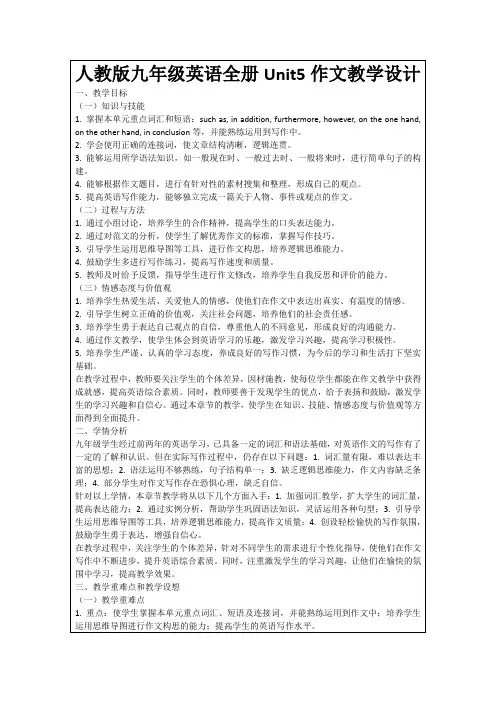
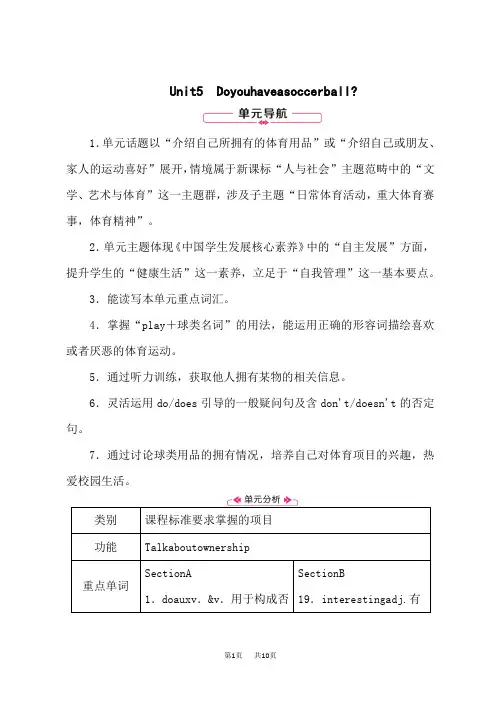
Unit5 Doyouhaveasoccerball?1.单元话题以“介绍自己所拥有的体育用品”或“介绍自己或朋友、家人的运动喜好”展开,情境属于新课标“人与社会”主题范畴中的“文学、艺术与体育”这一主题群,涉及子主题“日常体育活动,重大体育赛事,体育精神”。
2.单元主题体现《中国学生发展核心素养》中的“自主发展”方面,提升学生的“健康生活”这一素养,立足于“自我管理”这一基本要点。
3.能读写本单元重点词汇。
4.掌握“play+球类名词”的用法,能运用正确的形容词描绘喜欢或者厌恶的体育运动。
5.通过听力训练,获取他人拥有某物的相关信息。
6.灵活运用do/does 引导的一般疑问句及含don't/doesn't 的否定句。
7.通过讨论球类用品的拥有情况,培养自己对体育项目的兴趣,热爱校园生活。
续表【课时建议】本单元建议5课时SectionA(1a-1c)(一课时)SectionA(2a-2d)(一课时)SectionA(GrammarFocus-3c)(一课时)SectionB(1a-1d)(一课时)SectionB(2a-SelfCheck)(一课时)词汇短语:主要采用图片及多媒体展示助记法。
基本句子:采用多媒体展示及交际法(利用多媒体展示两人进行交际时的情景)。
语法:就本单元话题“The sporting goods they own”运用一般疑问句谈论物品所属关系,采用freetalk加深印象。
第一课时SectionA (1a-1c)Step1 情景导入【参考案例】T:Lookatthesportsthings.Here,thepingpongballismine.Itbel ongstome.SoIhaveapingpongball.“Have”isan importantverbinthisunit.Nowlistencarefully:Doyouhaveapingpongball?I'maskingyouifyouhaveapingpongball.Ifyouhave,say“Yes,Ido.”;ifnot,say“No,Idon't.”设计意图:通过提问引出本课的语言目标,在师生问答中自然而然导入新课。
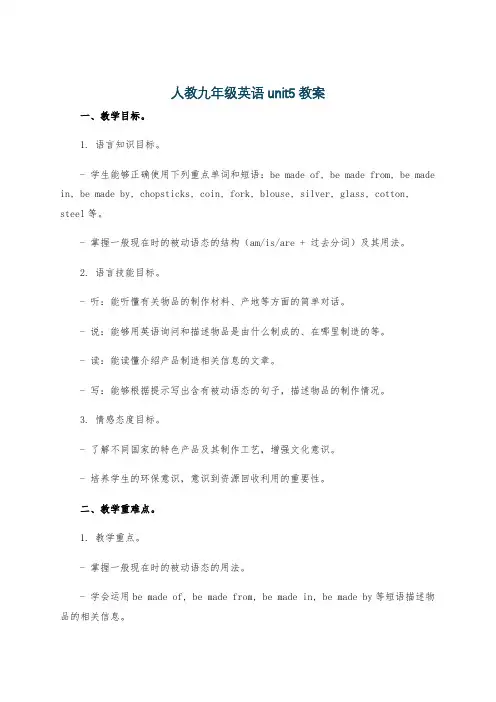
人教九年级英语unit5教案一、教学目标。
1. 语言知识目标。
- 学生能够正确使用下列重点单词和短语:be made of, be made from, be made in, be made by, chopsticks, coin, fork, blouse, silver, glass, cotton,steel等。
- 掌握一般现在时的被动语态的结构(am/is/are + 过去分词)及其用法。
2. 语言技能目标。
- 听:能听懂有关物品的制作材料、产地等方面的简单对话。
- 说:能够用英语询问和描述物品是由什么制成的、在哪里制造的等。
- 读:能读懂介绍产品制造相关信息的文章。
- 写:能够根据提示写出含有被动语态的句子,描述物品的制作情况。
3. 情感态度目标。
- 了解不同国家的特色产品及其制作工艺,增强文化意识。
- 培养学生的环保意识,意识到资源回收利用的重要性。
二、教学重难点。
1. 教学重点。
- 掌握一般现在时的被动语态的用法。
- 学会运用be made of, be made from, be made in, be made by等短语描述物品的相关信息。
2. 教学难点。
- 区分be made of和be made from的用法差异。
- 正确运用一般现在时的被动语态进行书面表达。
三、教学方法。
1. 情景教学法。
通过创设各种与物品制作相关的情景,让学生在真实的语境中学习和运用英语。
2. 任务驱动法。
布置各种任务,如小组讨论、角色扮演、调查等,让学生在完成任务的过程中提高语言综合运用能力。
3. 直观教学法。
运用图片、实物等直观教具,帮助学生更好地理解和记忆单词和短语。
四、教学过程。
(一)导入(5分钟)1. 展示一些常见物品的图片,如筷子、硬币、衬衫等,问学生:“What can you see in the pictures?”引导学生说出这些物品的英文名称。
2. 然后拿出一个用竹子做的筷子和一个用金属做的硬币,问学生:“What are they made of?”引出本节课的重点短语be made of。
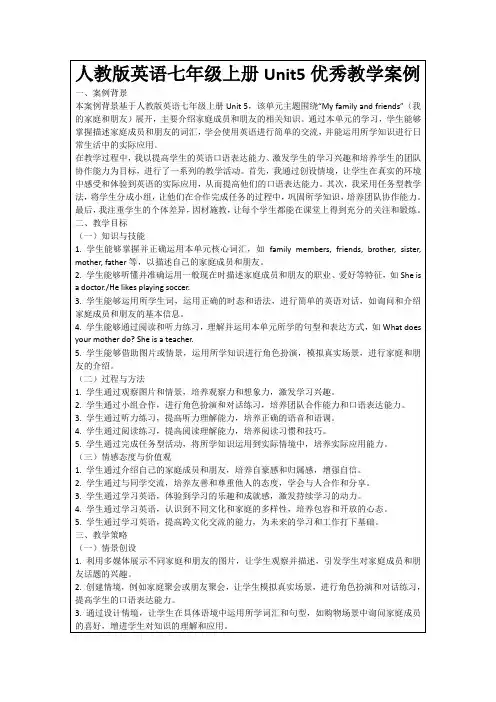
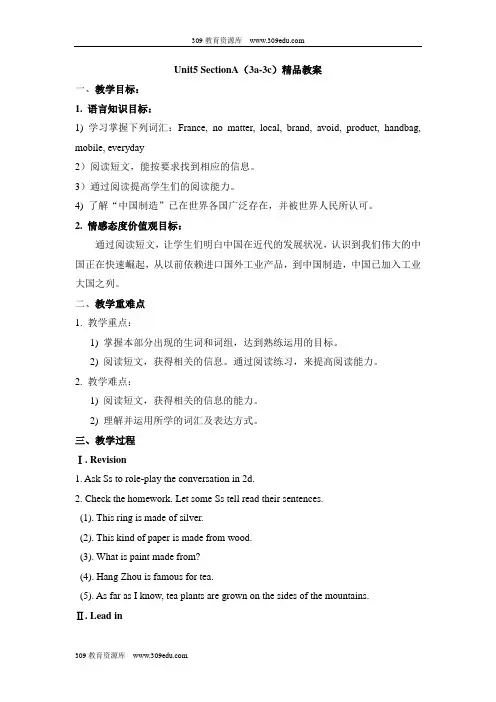
Unit5 SectionA(3a-3c)精品教案一、教学目标:1. 语言知识目标:1) 学习掌握下列词汇:France, no matter, local, brand, avoid, product, handbag, mobile, everyday2)阅读短文,能按要求找到相应的信息。
3)通过阅读提高学生们的阅读能力。
4) 了解“中国制造”已在世界各国广泛存在,并被世界人民所认可。
2. 情感态度价值观目标:通过阅读短文,让学生们明白中国在近代的发展状况,认识到我们伟大的中国正在快速崛起,从以前依赖进口国外工业产品,到中国制造,中国已加入工业大国之列。
二、教学重难点1. 教学重点:1) 掌握本部分出现的生词和词组,达到熟练运用的目标。
2) 阅读短文,获得相关的信息。
通过阅读练习,来提高阅读能力。
2. 教学难点:1) 阅读短文,获得相关的信息的能力。
2) 理解并运用所学的词汇及表达方式。
三、教学过程Ⅰ. Revision1. Ask Ss to role-play the conversation in 2d.2. Check the homework. Let some Ss tell read their sentences.(1). This ring is made of silver.(2). This kind of paper is made from wood.(3). What is paint made from?(4). Hang Zhou is famous for tea.(5). As far as I know, tea plants are grown on the sides of the mountains.Ⅱ. Lead in1. 展示一段伦敦奥运会礼品的视频,让学生了解中国制造已被世界人民所接受。
Then ask Ss some questions:T: As we know, there are so many things made in China in England. What about in America and other countries in the world? Now let’s read the passage of 3a. First, read quickly and find the answer to this question:1) Where did Kang Jian visit last year?2) Were there many things made in China in the US?3) What two things did Kang Jian want to buy in the US?4) Where were they made?Ss read the article quickly and try to answer the questions:2. 方法指导:带着问题,然后快速阅读短文,争取在较短的时间内,找到答案。
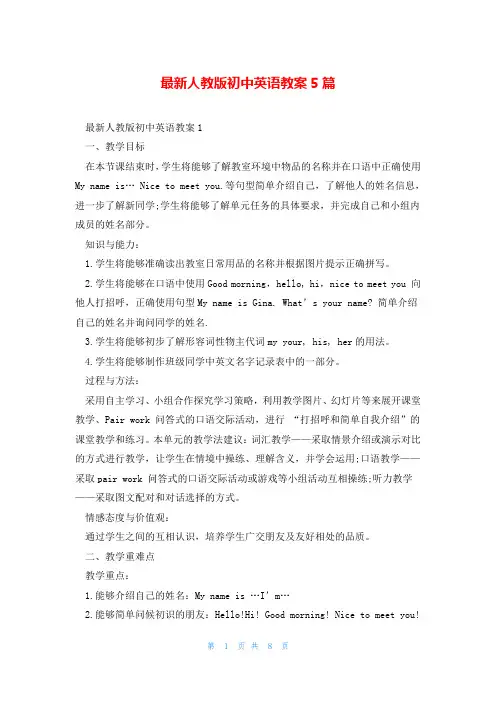
最新人教版初中英语教案5篇最新人教版初中英语教案1一、教学目标在本节课结束时,学生将能够了解教室环境中物品的名称并在口语中正确使用My name is… Nice to meet you.等句型简单介绍自己,了解他人的姓名信息,进一步了解新同学;学生将能够了解单元任务的具体要求,并完成自己和小组内成员的姓名部分。
知识与能力:1.学生将能够准确读出教室日常用品的名称并根据图片提示正确拼写。
2.学生将能够在口语中使用Good morning,hello, hi,nice to meet you 向他人打招呼,正确使用句型My name is Gina. What’s your name? 简单介绍自己的姓名并询问同学的姓名.3.学生将能够初步了解形容词性物主代词my your, his, her的用法。
4.学生将能够制作班级同学中英文名字记录表中的一部分。
过程与方法:采用自主学习、小组合作探究学习策略,利用教学图片、幻灯片等来展开课堂教学、Pair work 问答式的口语交际活动,进行“打招呼和简单自我介绍”的课堂教学和练习。
本单元的教学法建议:词汇教学——采取情景介绍或演示对比的方式进行教学,让学生在情境中操练、理解含义,并学会运用;口语教学——采取pair work 问答式的口语交际活动或游戏等小组活动互相操练;听力教学——采取图文配对和对话选择的方式。
情感态度与价值观:通过学生之间的互相认识,培养学生广交朋友及友好相处的品质。
二、教学重难点教学重点:1.能够介绍自己的姓名:My name is …I’m…2.能够简单问候初识的朋友:Hello!Hi! Good morning! Nice to meet you!3.能够正确使用形容词性物主代词my your, his, her三、教学策略词汇教学——采取情景介绍或演示对比的方式进行教学,让学生在情境中操练、理解含义,并学会运用;口语教学——采取 pair work 问答式的口语交际活动或游戏等小组活动互相操练;听力教学——采取图文配对和role-play的方式;四、教学过程最新人教版初中英语教案21、写课题(Topic)和课型(LessonType)课题相当于文章的标题,讲课时要首先告诉学生,并写在黑板上。
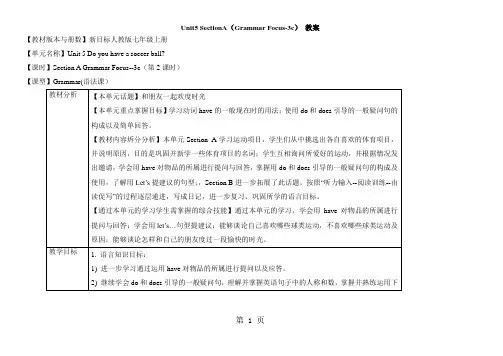
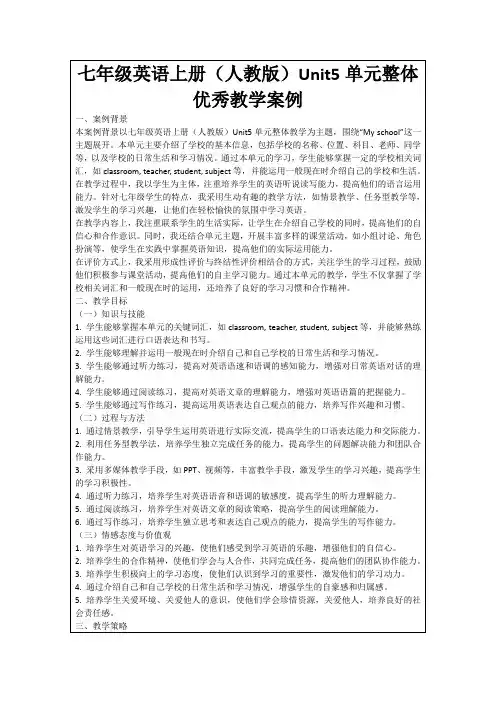
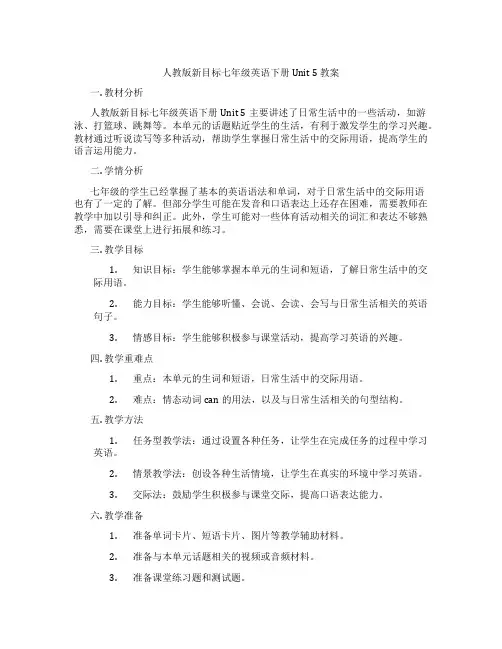
人教版新目标七年级英语下册 Unit 5 教案一. 教材分析人教版新目标七年级英语下册Unit 5主要讲述了日常生活中的一些活动,如游泳、打篮球、跳舞等。
本单元的话题贴近学生的生活,有利于激发学生的学习兴趣。
教材通过听说读写等多种活动,帮助学生掌握日常生活中的交际用语,提高学生的语言运用能力。
二. 学情分析七年级的学生已经掌握了基本的英语语法和单词,对于日常生活中的交际用语也有了一定的了解。
但部分学生可能在发音和口语表达上还存在困难,需要教师在教学中加以引导和纠正。
此外,学生可能对一些体育活动相关的词汇和表达不够熟悉,需要在课堂上进行拓展和练习。
三. 教学目标1.知识目标:学生能够掌握本单元的生词和短语,了解日常生活中的交际用语。
2.能力目标:学生能够听懂、会说、会读、会写与日常生活相关的英语句子。
3.情感目标:学生能够积极参与课堂活动,提高学习英语的兴趣。
四. 教学重难点1.重点:本单元的生词和短语,日常生活中的交际用语。
2.难点:情态动词can的用法,以及与日常生活相关的句型结构。
五. 教学方法1.任务型教学法:通过设置各种任务,让学生在完成任务的过程中学习英语。
2.情景教学法:创设各种生活情境,让学生在真实的环境中学习英语。
3.交际法:鼓励学生积极参与课堂交际,提高口语表达能力。
六. 教学准备1.准备单词卡片、短语卡片、图片等教学辅助材料。
2.准备与本单元话题相关的视频或音频材料。
3.准备课堂练习题和测试题。
七. 教学过程1.导入(5分钟)利用图片或视频引导学生谈论日常生活中喜欢的活动,引出本课话题。
2.呈现(10分钟)老师展示本课的生词和短语,让学生朗读并解释其意思。
同时,老师用情态动词can提问,引导学生回答。
3.操练(15分钟)学生分角色扮演,用情态动词can进行问答。
老师巡回指导,纠正发音和表达错误。
4.巩固(10分钟)学生完成课堂练习题,老师及时批改和讲解。
5.拓展(5分钟)老师引导学生谈论更多关于日常活动的表达,如游泳、打篮球、跳舞等。
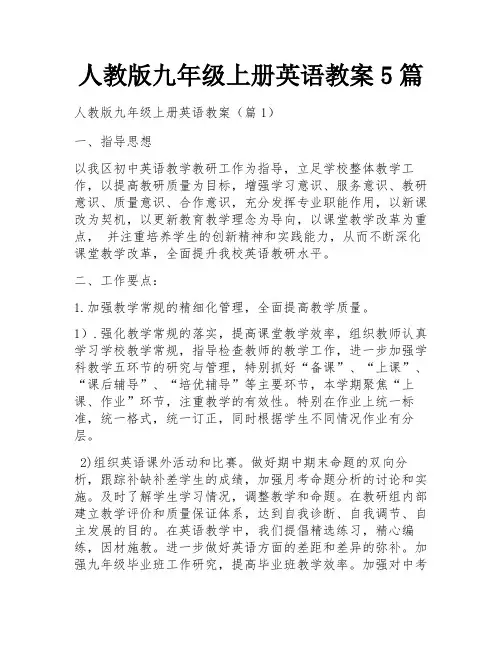
人教版九年级上册英语教案5篇人教版九年级上册英语教案(篇1)一、指导思想以我区初中英语教学教研工作为指导,立足学校整体教学工作,以提高教研质量为目标,增强学习意识、服务意识、教研意识、质量意识、合作意识,充分发挥专业职能作用,以新课改为契机,以更新教育教学理念为导向,以课堂教学改革为重点,并注重培养学生的创新精神和实践能力,从而不断深化课堂教学改革,全面提升我校英语教研水平。
二、工作要点:1.加强教学常规的精细化管理,全面提高教学质量。
1).强化教学常规的落实,提高课堂教学效率,组织教师认真学习学校教学常规,指导检查教师的教学工作,进一步加强学科教学五环节的研究与管理,特别抓好“备课”、“上课”、“课后辅导”、“培优辅导”等主要环节,本学期聚焦“上课、作业”环节,注重教学的有效性。
特别在作业上统一标准,统一格式,统一订正,同时根据学生不同情况作业有分层。
2)组织英语课外活动和比赛。
做好期中期末命题的双向分析,跟踪补缺补差学生的成绩,加强月考命题分析的讨论和实施。
及时了解学生学习情况,调整教学和命题。
在教研组内部建立教学评价和质量保证体系,达到自我诊断、自我调节、自主发展的目的。
在英语教学中,我们提倡精选练习,精心编练,因材施教。
进一步做好英语方面的差距和差异的弥补。
加强九年级毕业班工作研究,提高毕业班教学效率。
加强对中考走势的信息收集和测试研究,集中精力,争取在九年级中考中取得一个满意的成绩。
2.?以教科研引领,为教师的专业化成长打造新的平台。
1).大力开展校本教研,拓宽教师课程视野,逐渐成为学习型、反思型教师。
通过同伴互动。
充分发挥学校骨干教师、优秀教师的作用,通过“共享式的集体备课”、“探究式的课堂实践活动”和“专题式的学习讨论活动”等促进教师之间的互动,营造“集体备课、资源共享、个人加减、教后反思”的教研氛围。
结合优质课堂活动,并且推出一节具有代表性的研讨课。
(陈美红老师开课)2).根据各年级特点,进行一次主题教研活动。
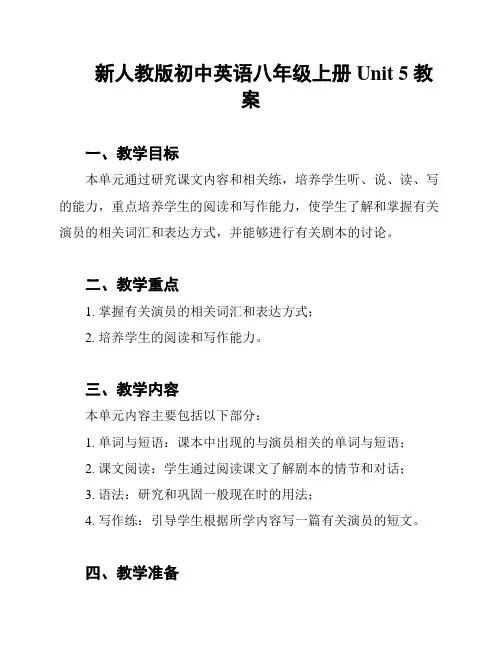
新人教版初中英语八年级上册Unit 5 教案一、教学目标本单元通过研究课文内容和相关练,培养学生听、说、读、写的能力,重点培养学生的阅读和写作能力,使学生了解和掌握有关演员的相关词汇和表达方式,并能够进行有关剧本的讨论。
二、教学重点1. 掌握有关演员的相关词汇和表达方式;2. 培养学生的阅读和写作能力。
三、教学内容本单元内容主要包括以下部分:1. 单词与短语:课本中出现的与演员相关的单词与短语;2. 课文阅读:学生通过阅读课文了解剧本的情节和对话;3. 语法:研究和巩固一般现在时的用法;4. 写作练:引导学生根据所学内容写一篇有关演员的短文。
四、教学准备1. 教学课件:包括演员相关的图片和课文内容;2. 黑板、粉笔;3. 学生练册。
五、教学步骤1. 导入- 让学生观看一段有关演员表演的视频片段,激发学生对演员的兴趣,并引导学生讨论演员的特点和工作内容。
2. 单词与短语研究- 通过图片和课件呈现与演员相关的单词和短语,教授其发音和意义,并让学生跟读和模仿。
3. 课文阅读- 让学生阅读课本中的剧本内容,了解剧情和对话,并回答相关问题。
4. 语法讲解- 介绍一般现在时的用法,让学生了解其基本结构和用法,并通过例句进行练。
5. 写作练- 引导学生进行有关演员的写作练,要求他们运用所学词汇和句型来表达演员的特点和工作内容,并提供必要的辅助材料和指导。
6. 小结与作业布置- 对本节课的重点内容进行小结,并布置相关的作业,如继续写作练或背诵重点词汇等。
六、教学评价1. 学生在课堂上的参与程度和表现;2. 学生在课后完成的作业质量和内容。
七、拓展延伸1. 安排学生集体表演一段简短的小剧场,让他们在实践中体验演员的工作;2. 组织学生进行关于演员的小组讨论,让他们互相交流和分享自己的见解;3. 鼓励学生阅读更多有关演员的文章和材料,了解不同类型的演员和表演风格。
人教版七年级英语优秀教案五篇写一份优秀教案是设计者教育思想、智慧、动机、经验、个性和教学艺术性的综合体现。
写好一份优秀的英语教案不容易,下面就是小编整理的七年级英语优秀教案,希望大家喜欢。
七年级英语优秀教案1Topic 1 I have a small nose.Section AThe main activities are 1a, 2a and 3a. 本课重点活动是1a, 2a和3a。
Ⅰ.Teaching aims and demands 教学目标1.Learn some new words:(1)Learn words about parts of the body:nose, eye, head, face, hair, ear, mouth, neck(2)Learn some other new words:guess, have, small, has, big, know, right, round, long, wide, girl, boy, short2. Learn some useful sentences:(1)Oh, I know.(2)Yes, you’re right.3. Learn the simple present tense with“have/has”and adjectives of description:(1)I have a big nose.(2)They have round faces.(3)She has long hair.(4)It has big ears.4. Learn how to describe people’s appearances.Ⅱ. Teaching aids 教具小黑板/影片的封面或图片/教学挂图/录音机Ⅲ. Five-finger Teaching Plan 五指教学方案Step 1 Review 第一步复习(时间:10分钟)通过复习,培养学生根据图画和文字信息进行简单交流的能力。
八年级上册英语教案人教版5篇八年级上册英语教案人教版篇1一、教材内容分析本课是人教版八年级上册英语第一单元第三个话题的第一课时,主要谈话讨论如何给别人提出建议,并给予适当的评论。
二、教学目标(知识,技能,过程与方法情感态度、价值观)1、知识与技能(1)掌握Why don’t you get her a scarf ? That’s too boring .这种句型,并认识新单词。
(2)运用新句型熟练的进行小组对话。
(3)进行听力练习。
2、过程与方法(1)能够通过师生说、两两说和自主听读体验交际式英语教学的一般过程,掌握英语说听的基本方法;(2)能够通过两两说和综合说体验合作学习的过程和方法;(3)能够仔细倾听老师和同学的发言,有语言表达和与同学交流的愿望。
(4)能够通过观看图片激发说话的欲望。
3、情感态度与价值观(1)培养学习英语的兴趣;(2)在学生两两交流和小组合作交流中,培养孩子合作意识和合作精神,能够相互配合完成一段通顺流畅的说话训练;(3)使学生学会礼貌待人。
三、学习者特征分析1、学生是八年级的学生。
2、学生已经学习了camera、hat,flowers 等物品的词。
3、学生对 great,interesting,boring 这些评论性的词非常熟悉。
4、学生好奇心强,对送什么礼物很感兴趣。
5、学生善于表现自己,乐于交际。
6、学生的听力能力不够强。
四、教学策略选择与设计1、谈话策略:运用谈话法引入新课。
2、自主听读策略:学生通过自主听读拓展材料,在完成课标要求的基础上训练听说能力,积累和丰富英语词汇和句式。
3、角色扮演法:让学生通过扮演不同角色,小组对话练习熟练地掌握重点句型。
五、教学环境及资源准备1多媒体教室。
2 本课教材,课件。
六、教学过程教学过程教师活动学生活动设计意图及资源准备Step1: Greeting Hello , cliass! How are you! Are you happy ... Greeting. 拉近教师和学生的距离。
人教版八年级英语教案上册Unit 5 教学设计一、教学目标(一)知识1. (1) 让学生掌握词汇:whom calendar invitation weekday(2)让学生掌握如何礼貌地发出、接受、拒绝邀请:can you come to my party? yes, i'd love to. / sorry, i can't. , invitation2. 教会学生掌握如何谈论自己或别人必须做的事情:i have to ...(二)水平使学生学会能够根据日程表中的计划安排自己的活动。
(三)情感教会学生礼貌地与人交流,珍惜友谊,热爱生活,有责任感。
二、教学重点让学生礼貌地发出、接受、拒绝邀请。
can you come to my party? yes, i’d love to. / sorry, i can’t.使学生能够根据日程表中的计划安排自己的活动并对邀请做出适当回答。
四、教学过程1.音乐导入,激发学生的学习兴趣:教师可先播放一段相关“聚会”的音乐,激发学生的学习兴趣并导入新知。
2. 完成任务,合作学习:教师能够给学生布置以下任务,让学生在完成任务的过程中掌握所学的知识。
任务一:planning a birthday party.让学生以小组为单位为某位同学筹备一个集体生日聚会,讨论在生日聚会上大家能够做哪些活动并列出清单。
任务二:writing an invitation card.学生以小组为单位展开活动,制作邀请卡向其他组的同学发出邀请,请他们来参加本组的集体生日聚会。
注意邀请卡的用词和基本格式。
任务三:统计聚会人数。
学生以小组为单位展开活动。
假设班上要组织一次野餐活动,一个学生为组织者,询问组员并统计本组参加的人数及不参加的原因,并做好记录。
group memberyes / no reasons完成任务可能要用到的语言结构:we are going to have a picnic. can you come?when is it going to start?i’m sorry. i have to....3. 拓展学习:学生设计假期某一周的日程安排。
Unit 5 What's this in English?一、教学目标与要求通过本单元教学,使学生运用所学句型,较为熟练地去辨别物体。
通过辨认物体,学到一些生词,并巩固所学句型。
二、教学重点与难点1、句型:Is this/that/it a pen? Yes,it is . No, it isn't.2、语法:1)初步学习代词this,that,it的用法;2)含有be动词的疑问句。
三、课时安排本单元共4课时,每课1课时。
第十七课Lesson Seventeen一、教学内容1、词汇(略)2、句型:What's this in English? It's a…二、教具录音机;与本课词汇有关的图片或实物。
三、课堂教学设计1、复习日常用语。
2、复习数词,认读电话号码、汽车牌号等。
3、用英语简单介绍自己。
(参照第4单元教案)4、复习What's this in English?的句型,操练中,运用第11课中所出现的词汇(如book,desk,pen等)。
运用这个句型,引出本课要学的词汇,如:clock,cup,pencil-box等。
用在11课中使用的方法(参照第11课教案)来教这些单词,并反复练习,直到学生熟练为止。
5、放课文录音,学生跟读。
两人一组,做第3题。
7、使用抄写本(或练习本),抄写练习1。
在教师指导下,朗读练习4。
如果时间允许,可请几组同学朗读。
8、布置作业1)用所学句型,练习辨认物体(限已掌握词汇范围),要求既能提问,又能应答;2)抄写生词以及练习1中的例句;3)在练习册上做练习2,并将单词译成汉语。
第十八课Lesson Eighteen一、教学内容1、词汇(略)2、句型:Is this a…?Yes,it is./No,it isn't.二、教具录音机;一个大书包,装有学习用具或一些水果。
三、课堂教学设计1、用What's this in English?的句型,复习上一课中学过的单词。
Language goal推荐一个教师必备工具“Yichafen”,是一个在线查分系统,全国8000所高校都在用,三分钟极速创建发布查分系统In this unit, students learn to talk about jobs.New languageWhat do you do? I'm a reporterWhat does he do.' He's a student.What do you want to be? I want to be an actor .What does she want to be? She wants to be a police officernames of jobs and professionsSection ABrainstorm with students a list of jobs that friends or relatives do. ("Brainstorming" is an activity in which you set a topic and students say whatever words they can think of relating to that topic.) Write the word jobs on the board and list all the jobs students mention.Point to the jobs one by one and ask students to say what ever they can about these jobs. Accept single word answers or simple sentences such as, It's fun. It's a good job.la This activity introduces the key vocabulary.Focus attention on the art. Ask students to tell what they see in each scene. Ask students to name as many of the jobs shown as they can. Then point to a scene, name the job, and ask students to repeat.Point to the numbered list of words. Say each one and ask students to repeat.Then ask students to match each word wllfa one of the scenes. Say, Write the letter of each scene next to one of the ivords. Point to the sample answer.1 b This activity gives students practice in understanding the target language in spoken conversation.Point to the different people shown in the picture.Ask various students to tell what they do as you point to each one,Say, Now you will hear three conversations. The conversations are about three of the people in this picture.Play the recording the first time. Students only listen.Play the recording a second time. This time ask students to write a number 1 next to the person being talked about in conversation 1. Have students put a 2 and 3 next to the people being talked about in conversations 2 and 3.Correct the answers.1 c This activity provides guided oral practice using the target language-Ask a student to read the example conversation with you. Hold up the book and point to the doctor in the picture.Say, Now work with your partner. Make your own conversations about the picture. You can use sentences like the ones in activity1b.Say a dialogue with a student. Point to a picture of one of the people. Guide the student to answer using one of the words inactivity 1a.As students work in pairs, move around the room monitoring their work. Oner language or pronunciation support as needed.2a This activity gives students practice in understanding the target language in spoken conversation.Ask students to look at the three pictures. Ask different students to tell you what they sec in each picture. What are the people doing? What jobs do they have?Play the recording the first time. Students only listen.Say, You will hear conversations about the people in these pictures.Play the recording a second time. Say, Write the number of each conversation below the picture of the person being talked about.Correct the answers.2b This activity gives students practice in understanding the target language in spoken conversation.Point to the three headings in the chart and read the headings to the class. Ask students, What does "wants to be" mean? (It is not the Job the person lias now. It is the job the person wants in the future.)Play the recording the first time. Students only listen.Say, You wiU hear about the people in these pictures. You will hear the job they haw now and the job they want in the future.Play the recording a second time. This time ask students to fill in the blanks with the jobs the people have now and the ones they want in the future. Point out the sample2c This activity provides guided oral practice using the target language.Point out the pictures in activity 2a. Ask who each person is. (They are Susan's brother. Anna's mother, and Tony's father.)Say, Now work with your partner. Ask and answer questions about the pictures. Ask, "What does he or she do?" Then ask, "What does he or she want to be?"Say a dialogue with a student. Point to Anna's mother and then to the example in the speech balloons. Practice the dialogue with a student.As students work In pairs, move around the room monitoring their work. Offer language support as needed.3a This activity introduces the names for the places where people work, and gives reading practice using the target language.Call attention to the pictures. Ask students to read the name for each place. As they name each place, write the word on the board and-ask the class to repeat it.Point out the list of jobs with the numbers next to each. Then call attention to the people in the pictures and the speech bubbles. Point out the sample answer and have a student read out the speech bubble.Ask students to work alone. Say, Write the number of each job in the square next to each workplace.Check the answers.3b This activity provides guided oral practice using the target language.Point out the pictures in activity 3a. Ask students to name the workplace shown In each picture.Then point out the conversation in the speech bubbles. Ask two students to read It to the class.Say, Wow work with a partner. First practice the conversation in the picture. Then make new conversations. Use jobs and places from activity 3a.Say a dialogue with a student. Point to the word waiter inactivity 3a and then to the picture of the restaurant. Ask a student. Where does he work? Guide the student to answer using the correct place: He works in a restaurant.Then ask. What does he do? and guide the student to answer, He's a waiter.As students work in pairs, move around the room monitoring their work. Offer language support as needed.4 This activity provides listening and speaking practice using the target language.Call attention to the pictures in the book showing how to play the game. Say, You will draw a picture of someone working. Other students will ask questions about the kind of job you are drawing. After two questions someone can try to guess the job.Demonstrate by drawing a picture on the board of a stick figure reporter. Add details (microphone, notebook,etc.) until students guess what job it is.Ask a student to go to the board. Say, Draw a picture of a person working. If necessary, help the student add details that show the job the person is doing. He or she can add a bank interior to show that the person is a bank clerk. A student could also use an eye chart on the wall to show that the place is a doctor's office and the personis a doctor.Ask two different students to ask questions about the Job, and then ask a third student to guess what job it is.Play the game using drawings by several different students.Alternative: If you do not want students to move from their seats, then you can ask them to do this activity sitting down in groups of four. They will need pieces of paper on which to draw their pictures. They will also need pencils.Section BNew languageWords that describe jobs, such as exciting, dangerous,boring, difficult, busy, funAdditional materials to bring to class:help wanted ads from an English-language newspaper1 a This activity introduces the key vocabulary.Focus attention on the six pictures. Ask, What job does the person have? Where does the person ivnrk?Point out the numbered list of words. Say each one and ask students to repeat. Then use simple explanations and short sample sentences to help students understand what each word means. For example, Exciting means very interesting and very fast-moving. A police officer has an exciting job. The job is always changing. Something is always happening. For dangerous you might say, Dangerous means not safe. You might be hurt or killed in a dangerous job.Then ask students to match each word with one of the pictures. Say, Write the letter of each picture next to one of the words. Point out the sample answer.Check the answers.1 b This activity provides guided oral practice using the target language.Call attention to the picture In this activity and ask a student to read the statement to the class. Then point to the picture of the police officer and say. It's an exciting job. Ask the class to repeat. Then say, What else can you say about being a police officer? Someone may answer, It's a dangerous job. Ask the class to repeat each correct answer.Then ask students to work in pairs. Suggest that they each point to the pictures of the workers and make statements about them. As students practice, move around the classroom monitoring their work.1 c This activity provides an opportunity for oral practice.Say, Name some of the jobs from this unit. Write this list of jobs on the board. Say, Can you name some other jobs? Add any new jobs to the list.Ask some students to make statements about Jobs on the list using the words in activity la. You may wish to write some of the sentences on the board so that students can copy the sentences into their notebooks.2a This activity provides listening and writing practice with the target language.Call attention to the two headings and ask a student to read die headings to the class.Point out the blank lines where students will write the name of a job (under the words wants to be).Play Ihe recording the first time. Students only listen.Say, Now I will play the tape again. This time write the name of a job under the words "wants to be."2b This activity provides listening and writing practice with the target language,Call attention to the second heading and ask a student to read it to the class. Say, This time you will unite why each person wants the job.Play the recording again. Students only listen.Then say, Now I will play the tape again. This time write the reason the person wants the job under the word "Why?"Play the recording. Students write their answers.Check the answers.2C This activity provides open-ended oral practice using the target language.Say, What do you want to be? What words describe each job? Help the class make up a list of jobs they might like to do. As students suggest possible jobs, ask the class to suggest words to describe them. Use a bilingual dictionary, if necessary, to find the names of jobs and words to describe each one.Then ask students to work in small groups. They tell each other what they want to do and why. Encourage students to use dictionaries if necessary. Move from group to group offering assistance as needed.Ask individual students to tell the class about what they want to be and why.3a This activity provides reading and writing practice using the target language.Call attention to the three newspaper ads and read these ads to the class. Say blank each time you come to a blank line.Then read each ad again separately, pausing to allow students to ask questions about anything they don't understand. For example, in the first ad, students may not know that working late means "working at night." To work hard means to use a lot of energy to do the job.Ask students to fill In (he blanks in the ads using the words actor, reporter, and waiter.Check the answers.3b This activity provides reading and writing practice using the target language.Call attention to the newspaper ad and ask a student to read it, saying blank for each blank line.Ask students to fill in the blanks using words from This section. Say,Look at the pictures next to each blank line. The pictures will help you guess the correct word.Suggest that they look at the namesof jobs and the words that describe jobs in the first part of Section B.Check the answers,3c This activity provides writing practice using the targetlanguage.Point out the blank strip of newspaper where students can write their own ads.Ask one or two students, What are you going to write about? Repeat each of the students' sentences and ask the class to repeat the sentences after you. For example: Do ^OM want an interesting but dangerous job? Do you want to meet new people? We need a police officer.Call the Smithtown Police Station at 555-2323.Ask students to read their ads to a partner. Ask the pairs to correct each other's work.4 This activity provides guided oral practice using thetarget language.Ask two students to read the conversation in the speech bubbles. Answer any questions students may have about it.Then say, New please work in groups. Ask efuestions to find out what jobs each person wrote about. You can use sentences like the ones we just read.As students ask questions, move from group to group. Rephrase any incomplete or incorrect questions.Also rephrase any inaccurate answers.在工作学习中,我们经常会遇到初中人教版英语教案这样的问题。